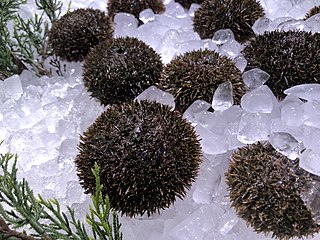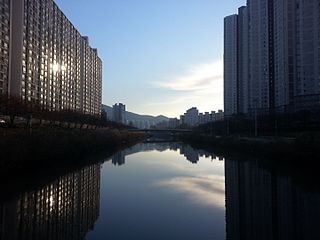Related Research Articles

Sea urchins, are typically spiny, globular animals, echinoderms in the class Echinoidea. About 950 species live on the seabed, inhabiting all oceans and depth zones from the intertidal to 5,000 metres. Their hard shells (tests) are round and spiny, usually from 3 to 10 cm across. Sea urchins move slowly, crawling with their tube feet, and sometimes pushing themselves with their spines. They feed primarily on algae but also eat slow-moving or sessile animals. Their predators include sea otters, starfish, wolf eels, triggerfish, and humans.

Hemicentrotus pulcherrimus is a species of sea urchin, the only one in the monotypic genus Hemicentrotus. It was first described by the American engineer and marine zoologist Alexander Agassiz in 1864 as Psammechinus pulcherrimus. Its range extends along the coasts of Korea and China, and in Japan from Kyūshū to Ishikari Bay. An edible species, it is harvested from Kyūshū to Fukui, in the Sea of Japan.

The Strongylocentrotidae are a family of sea urchins in the order Echinoida.

2,3,5,7-Tetraahydroxy-1,4-naphthalenedione, also called 2,3,5,7-tetrahydroxynaphthoquinone or spinochrome B, is an organic compound with formula C
10H
6O
4, formally derived from 1,4-naphthoquinone through the replacement of four hydrogen atoms by hydroxyl (OH) groups.
Jeotgalicoccus marinus is a species of Gram-positive, facultatively anaerobic bacteria. It is moderately halophilic, it grows in environments with 0.5–25.0 % total salts. The cells are coccoid. The species was isolated from a sea urchin from the South China Sea.

Love or Spend is a 2015 Taiwanese television series starring Kingone Wang, Ling Hung, Jolin Chien, Dayuan Lin and Li Jing Tian. Shooting began on October 23, 2015, and wrapped up on February 22, 2016. The original broadcast began on November 4, 2015, on SETTV, airing weekdays at 8:00 pm.

Oncheon-cheon is a tributary of the Suyeong River in Busan, South Korea. It was previously known as the Seocheon or Dongnaecheon. The source of the river is on Geumjeongsan. It then flows through the built-up area of Busan, passing between Allak-dong and Yeonsan-dong along the way.
Arenibacter echinorum is a heterotrophic and aerobic bacterium from the genus of Arenibacter which has been isolated from the sea urchin Strongylocentrotus intermedius from the Sea of Japan.
Chryseobacterium echinoideorum is a Gram-negative, rod-shaped, aerobic and non-motile bacteria from the genus of Chryseobacterium which has been isolated from a sea urchin on the Penghu Island on Taiwan. Chryseobacterium echinoideorum produces flexirubin.
Acrosorium polyneurum is a species of red algae first described by Okamura. It grows in intertidal and shallow subtidal waters in Japan where it is grazed by the sea urchin Hemicentrotus pulcherrimus.
Salegentibacter chungangensis is a Gram-negative, strictly aerobic and rod-shaped bacterium from the genus of Salegentibacter which has been isolated from a marine sand.
Salegentibacter holothuriorum is a Gram-negative, strictly aerobic and non-motile bacterium from the genus of Salegentibacter which has been isolated from the sea cucumber Apostichopus japonicus from the Sea of Japan.
Salegentibacter mishustinae is a Gram-negative, strictly aerobic, heterotrophic and non-motile bacterium from the genus of Salegentibacter which has been isolate from a sea urchin from the Sea of Japan.
Salegentibacter salarius is a Gram-negative, rod-shaped and non-motile bacterium from the genus of Salegentibacter which has been isolated from a marine solar saltern from the Yellow Sea.
Salegentibacter salinarum is a Gram-negative, rod-shaped and non-motile bacterium from the genus of Salegentibacter which has been isolated from a marine solar saltern from the Yellow Sea.
Salegentibacter sediminis is a Gram-negative, aerobic, rod-shaped and non-motile bacterium from the genus of Salegentibacter which has been isolated from sediment obtained from the coast of Weihai.
Salinimicrobium catena is a Gram-negative, aerobic, heterotrophic and non-motile bacterium from the genus of Salinimicrobium which has been isolated from sediments oft the South China Sea.
Winogradskyella echinorum is a bacterium from the genus of Winogradskyella which has been isolated from the sea urchin Strongylocentrotus intermedius.
Tangfeifania is a Gram-negative, facultatively anaerobic and non-motile genus of bacteria from the family of Prolixibacteraceae with one known species. Tangfeifania diversioriginum has been isolated from the saltwater lake Gahai in China.
Trichococcus alkaliphilus is a psychrotolerant and facultative anaerobic bacterium from the genus Trichococcus which has been isolated from the Zoige Wetland from the Qinghai-Tibetan Plateau.
References
- 1 2 "Species: Salegentibacter echinorum". LPSN.DSMZ.de.
- 1 2 Xia, Hai-Feng; Li, Xiao-Li; Liu, Qian-Qian; Miao, Ting-Ting; Du, Zong-Jun; Chen, Guan-Jun (1 September 2013). "Salegentibacter echinorum sp. nov., isolated from the sea urchin Hemicentrotus pulcherrimus". Antonie van Leeuwenhoek. 104 (3): 315–320. doi:10.1007/s10482-013-9950-0. PMID 23754662. S2CID 8407517.
- ↑ "www.uniprot.org".Cite journal requires
|journal=(help)